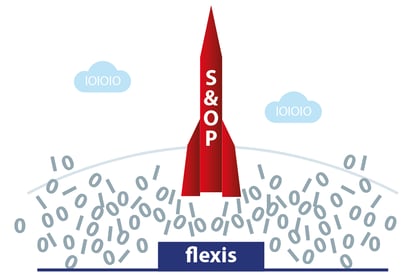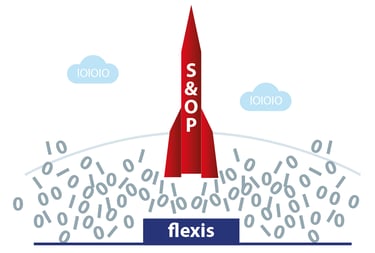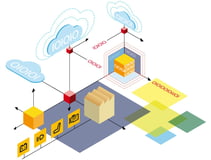Can the Right Technology Jumpstart Your Sales & Operations Planning?
Brian Hoey - September 17, 2019

 People say that the only constant is change. When they say that, they’re usually not talking about sales and operations planning (S&OP). And yet, what could be more relevant? If you’re an automaker, for instance, your business constantly needs to adapt to changing market conditions, customer expectations, technological realities, and other factors that can have a big impact on the success of your production plans, supply chain, and profits. There are any number of strategies that decision-makers use to try and address these constant internal and external changes, but one of the most commonly talked about (in some circles, anyway) is S&OP.
People say that the only constant is change. When they say that, they’re usually not talking about sales and operations planning (S&OP). And yet, what could be more relevant? If you’re an automaker, for instance, your business constantly needs to adapt to changing market conditions, customer expectations, technological realities, and other factors that can have a big impact on the success of your production plans, supply chain, and profits. There are any number of strategies that decision-makers use to try and address these constant internal and external changes, but one of the most commonly talked about (in some circles, anyway) is S&OP.
The relevant question, of course, is how do you make sure those S&OP workflows succeed—i.e. how do you maximize the chances that they really will stave off disruptions and better align output with demand? After all, it’s not uncommon to see these kinds of planning flows go awry for any number of reasons, from low visibility to poor execution. How can planners ensure that they’re really implementing this process in a value additive way, rather than creating more work and confusion at other touchpoints on the supply stream. Well, it typically starts with the right technology.
Why Do S&OP Workflows Fail?
Before we dig into the ways that technology can potentially help improve your ability to match your factory’s output to real, emerging demand, let’s talk about some of the ways that S&OP processes can go wrong.
- Inaccurate forecasting
- Data/decision making silos
- Poor reporting
- Low levels of intra-operational collaboration
- Poor execution
There are others that crop up from time to time, but by and large your average S&OP failure is going to fall into one—or, more likely, several—of these categories. Indeed, each of these issues has to potential to impact the others, resulting in a cascade effect that makes disruptions that much more likely. If your most recent spate of customer orders, for instance, is stuck behind an information silo, it will be more difficult for your forecasting workflows to account for the trends they represent. Thus, they’ll be more likely to err in one direction or the other. By the same token, if departments can’t collaborate with one another, execution becomes even more difficult to do right. This creates further disruptions, which can have an additional cascade effect on execution and collaboration down the road by leeching off the time and resources of those who are scrambling to make things right.
How The Right Technology Can Help
Now that we’ve seen some of the most common causes of S&OP failures, the relevant question is: how can technology specifically address them? For some, the answer appears pretty straightforward: if your forecasting quality is low, your planning flows could probably benefit from advanced predictive analytics, which are designed precisely for the purpose of improving forecast quality. On the other hand, things like collaboration and execution might seem like operational problems rather than technological ones. In both of these cases, however, there is more than a little gray area. Though forecasting appears, to some extent, to be a simple matter of finding the right software and plugging in the numbers, you first need to ensure that the numbers in question are actually accessible—which means breaking down information silos, which itself might mean creating more alignment between different touchpoints on the value chain. Conversely, collaboration can actually be aided by the right technological tools; in a postmodern ERP environment, for instance, the interconnection between disparate functional IT infrastructures makes it possible to share data and work together cross-functionally in a way that many teams in less sophisticated IT ecosystems struggle to do.
If there’s a common theme here, it’s this: the first step in leveraging technology to empower your S&OP processes is to prioritize data visibility and transparency. Why? Because that’s the essential building block that makes it possible to improve forecasts, promote collaboration, create useable reports, and root out silos. Without those potential disruptions to worry about, you position yourself to anticipate future demand levels and successfully organize your supply chain and production scheduling to hew to those demand levels. Of course, there is a great deal of complexity to matching your supply chain operations to your sales expectations, but with high levels of visibility you can usually let advanced analytics processes work their magic. If you’re anticipating a demand spike for a particular product, for instance, you could use digital twins (i.e. digital copies of your production plants) to optimally reorganize your production ratios. In this way, your existing planning process is enhanced by technology that helps you to estimate the likely effects of proposed changes and adjustments.
Moving Beyond S&OP
Okay, so we’ve seen how technology can help you to overcome many of the hurdles that present themselves to S&OP planners—but could we really characterize that as “jumpstarting?” If we take successful S&OP as a baseline, the question now becomes: how do we add even more value on top of that? By our reckoning, the answer here is by implementing S&OE, or sales and operations execution. This process is designed to bridge the gap between longer term S&OP plans and daily or weekly supply chain functioning by giving planners real time data with which they can make small adjustments to transport plans and inventory levels.
This, of course, is an area where technology is invaluable. In order for these functions to add value, they need access to a constant stream of real-time demand information and live monitoring of transport flows and inventory levels. The visibility-boosting we discussed above is essentially a prerequisite to this level of data velocity, paving the way for IoT devices, RFID sensors, and other smart equipment that can help make S&OE possible. And what’s the value-add here, you ask? Simply put, these workflows radically reduce the potential for disruption within a larger S&OP plan by stopping potential misalignments before they start. More than that, S&OE helps to provide a real-time snapshot of your supply chain that can help longer-term planners to better understand current realities. It may require levels of technology integration approaching Industry 4.0, but the result is more efficient execution and a valuable source of feedback within the value chain.
LATEST POSTS
- Understand Circular Economy in The Manufacturing Industry
- How Can Industry 4.0 IT Integration Be Achieved Smoothly?
- The Significance of Order Sequencing in Discrete Manufacturing
- How to improve your Supply Chain Management: The Power of Control Towers
- Optimizing Human Resource Scheduling in Manufacturing: A Technological Approach



